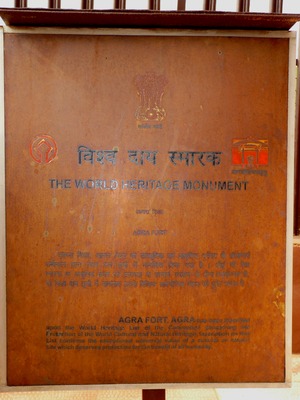Agra Fort

Agra Fort is a highlight in Indo-Islamic Mughal art and architecture.
The fortress enclosed the imperial city of the Mughal rulers, who ruled from there until 1638. Entered by monumental gates, it holds a large number of palaces and two white marble mosques. The original complex was built by Emperor Akbar in red sandstone; major monuments executed in marble were added by Shah Jahan in the 17th century.
Community Perspective: It lies close to the Taj Mahal and is better visited first, as otherwise, it can only disappoint. Visit it for an insight into the lifestyle of the Mughal rulers.

Map of Agra Fort
Community Reviews
Alikander99

I agree with the general sentiment that the red fort and agra Fort are virtually indistinguishable. No doubt helped by the fact that both have significant historical overlap in their structures.
Weirdly enough, I remember agra Fort as more interesting than the red fort, but when checking back the photos I tend to like the red fort better. Overall I think both have a place in the list as examplary complexes. Imo the most diferenciating aspect, and one that I particularly enjoyed was the persistence of some akbarite architecture in Agra. In this sense I think Agra Fort showcases the changes in earlier mughal architecture much better than Delhi.
Campmany

Most visitors likely visit the place after seeing the Taj Mahal. This might impact the overall impression after visiting such an incredible monument. Nevertheless, the Fort is quite impressive, this is a huge fortification with several gardens and palaces inside it. Some buildings have nice views of the Taj Mahal far away. I visited the fort at 9.30 in the morning on a Saturday, there were no queues and I enjoyed visiting most of the places empty of visitors. No "official" guides outside the gate to offer their services, so overall very enjoyble experience.
Jean Lecaillon

The Agra Fort is a huge fort very similar to the Red fort in delhi. To be honnest, i'm not able to distinguish either one if i had two pictures in front of me. But, contrary to the red fort, i visited this one.
It's quiet interesting but not so much beautiful compared to all the indian monuments they can build. I mean it's not the best souvenir i had in India. However, the size of the red stones are impressive. And it's rare i guess: you can see another WHS from this WHS! It's obviously the famous Taj Mahal, along the Yamuna river. We could start a thread on the forum about such possibility: to see a WHS from another one? :) (maybe it already exists, i didn't verify)
Clyde

Similar to the Red Fort in Delhi but still worth visiting. I visited this WHS in December 2011 and was struck by the architecture of this site, especially the several arches adorning the courtyards. Beware of the seemingly innocent monkeys around the site. My camera zoom lens was split-seconds away from being bitten by one of the monkeys, but as soon as I was pressing the button to take a picture I noticed a sudden movement and luckily my instinct told me to move sideways. That way the monkey attack wasn't successful and instead I ended up with a very close-up photo of an angry monkey showing off its fangs!
Frederik Dawson

Agra Fort, an enormous red sandstone fortress on the bank of Yamuna River in the center of Agra. This fort is not just a military fortress, but also an imperial palace that was a power center of the whole Mogul Empire.
I visited Agra Fort on such a very important day, the day that Taj Mahal celebrated her 350th birthday. The celebration for Taj Mahal, but Indians celebrated in Agra Fort! Why? The answer is Indian Supreme Court did not allow celebrating in Taj Mahal so the celebrations have to move to the Fort. I do not understand the logic, the court want to protect Taj Mahal, a world heritage site, but they allow a grand party in Agra Fort which also a world heritage site and should receive equally protection! When I visited, the Hall of Public Audience was full with electronic machines that will make light and sound for the party, a lot of chairs and many polices, it was a really messy place. Thankfully that all such mess was not expand to other areas, the palace was still amazingly calm and made my mood back to normal. The palace in Agra Fort can be divided into two sections based on material, red sandstone and marble. The red sandstone buildings mean they were built before Shah Jahan or early years of his reign, the marble means they were built by Shah Jahan, an emperor who built Taj Mahal. The marble sections are absolutely breathtaking with marble inlay with colored stone and the view of Taj Mahal is incredible made me understood how sad of Shah Jahan when he was imprisoned and saw Taj Mahal everyday, so close but can not go there. The red sandstone sections were mainly built by Akbar for his son, Emperor Jahangir, with superb quality of stone carving similar to Fatehpur Sikri.
Agra Fort is a great place, the best place to understand how the imperial court of Mogul looked like as the lifestyle of each emperor can be seen in their private apartment. This place is a must for everyone who loves history and everyone who comes to Agra. One thing from Taj Mahal celebration, the old city of Agra was repainted in red colors, I didn’t know the city’s policy but if Agra wants to copy Jaipur’s Pink City tourist slogan and becomes Red City, I think they should invest their money that used for repainting on repairing roads in Agra’s old town which will make many tourists happier than seeing whole city in red!
Christer Sundberg

The Agra Fort - the second of the city of Agra’s main tourist attractions – was founded in 1565 and is a virtual copy of the Red Fort in Delhi. My understanding is that the latter is now also underway to also become a World Heritage Site, which is not more than fair.
The Agra Fort is huge and still mainly occupied by the Indian Army. Its massive sandstone walls rise over 20 meters and 2,5 km in circumference. Inside the fort you find different palaces and semi-palaces, Harem quarters, Halls of Public and Private Audiences and everything else needed to run an Empire in 15th century India. And also the Musamman Burj, were the aging emperor Shah Jahan spent his last years and where he lay on his death bed, gazing at the distant Taj Mahal where his long lost love, Mumtaz Mahal was buried.
The Agra Fort is an interesting visit but one can’t help that after having visited Agra’s major attraction, the Taj Mahal, it’s hard to see the same beauty in this still very exquisite palace. My recommendation when visiting Agra is that you FIRST visit the Agra Fort and then the Taj Mahal. Otherwise the almost unreal beauty of the Taj might distance you completely from what beauty the Agra Fort actually has to offer you.
Community Rating
- : Wojciech Fedoruk Craig Harder Stanislaw Warwas Lukasz Palczewski BH Aspasia Travelure Juropa Mihai Dascalu Trine Amitlchoudhuryjbp Roxfts Sofia84
- : Kevin McFarland Xtopher33 Debojyoti Dey Mazumder Jsrinivasan Lembu
- : Gary Arndt Elisabeth Fransisca Situmorang Chalamphol Therakul Randi Thomsen Alexander Parsons Chenboada Ge zhang Daniel Gabi Ralf Regele Riccardo Quaranta YAO WEI Alexander Lehmann Thomas Kunz Hurrvinek HaraldOest Hanming Priyaranjan Mohapatra Subhayan_svnit Dutchnick Mauralin13 Adiaro18 GatorTravel J_neveryes Campmany Fede1203 Felicité Javier BMuramatsu
- : Frederik Dawson Tony H. Timothy C Easton Bernard Joseph Esposo Guerrero Zoë Sheng David Marton Luke LOU Tevity Jakubmarin Dorejd Tarquinio_Superbo Alikander99 Gordon Mitchell GerhardM
- : Els Slots Philipp Peterer Clem C Nan Svein Elias Xiquinho Silva Sachin Jean Lecaillon Shandos Cleaver Christravelblog Lucio Gorla Carlo Sarion Richard Stone Mahuhe Bag-packer-family Philipp Leu Kelseyyurek Wimmy Jon Opol Yongcheng Liu
- : Solivagant Clyde Travtasy Lichia Akhilpreeti
- : Wieland
Site Info
Site History
1983 Inscribed
Site Links
Unesco Website
Official Website
In the News
Connections
The site has 21 connections
Art and Architecture
Constructions
Geography
History
Individual People
Religion and Belief
Timeline
Trivia
Visiting conditions
WHS Hotspots
World Heritage Process
Visitors
457 Community Members have visited.
The Plaque
 (photo by Clyde)
(photo by Clyde)